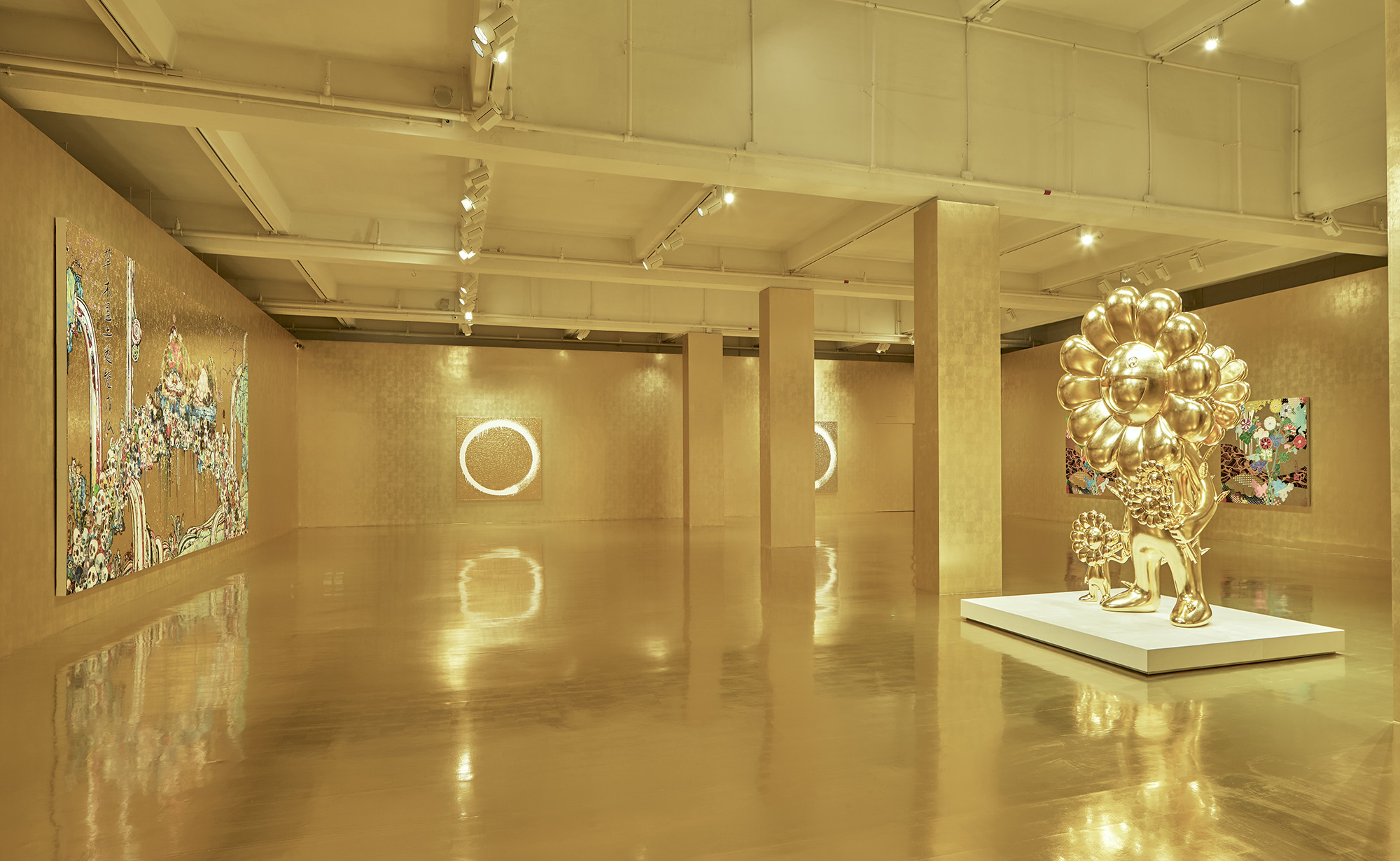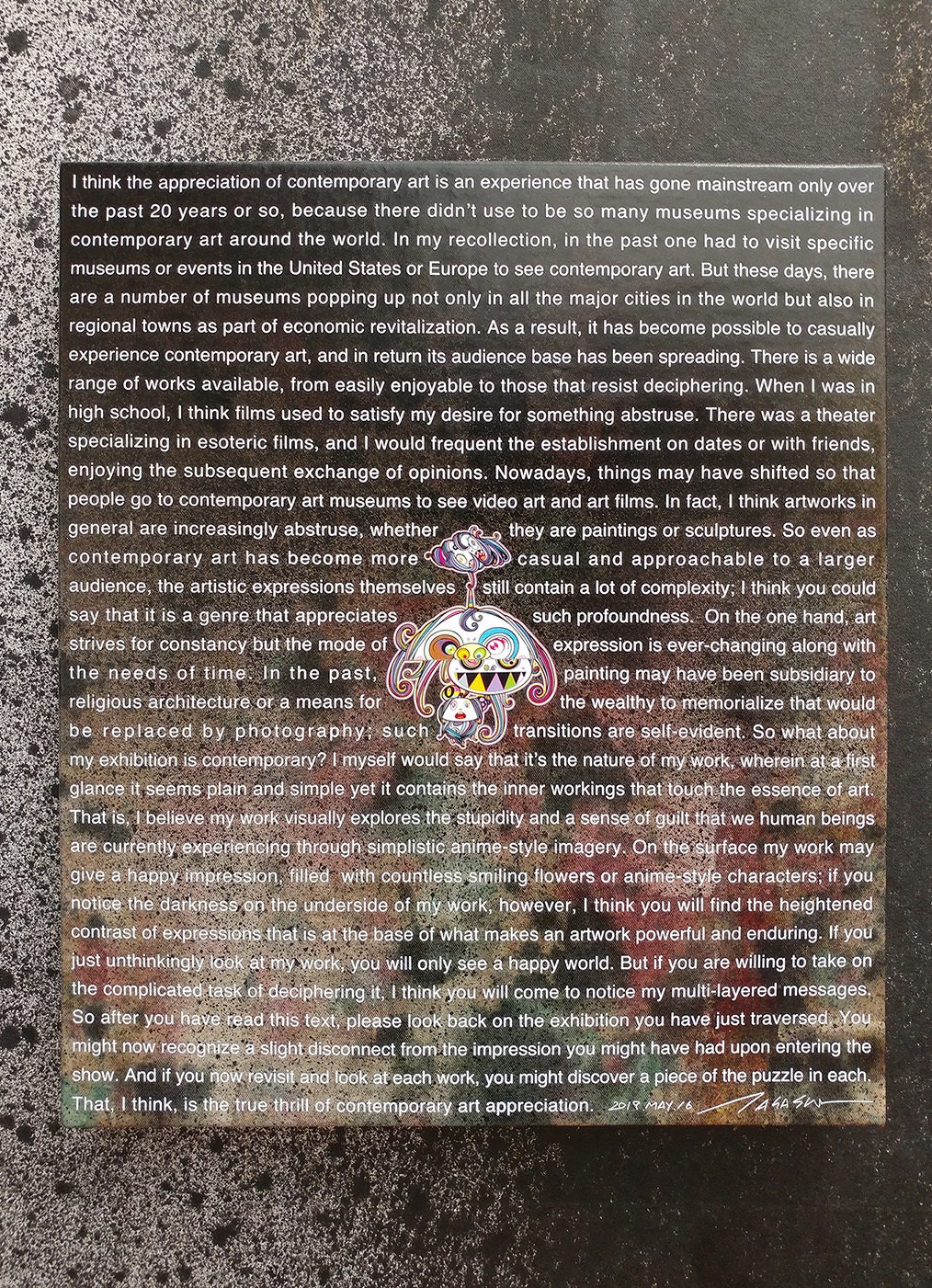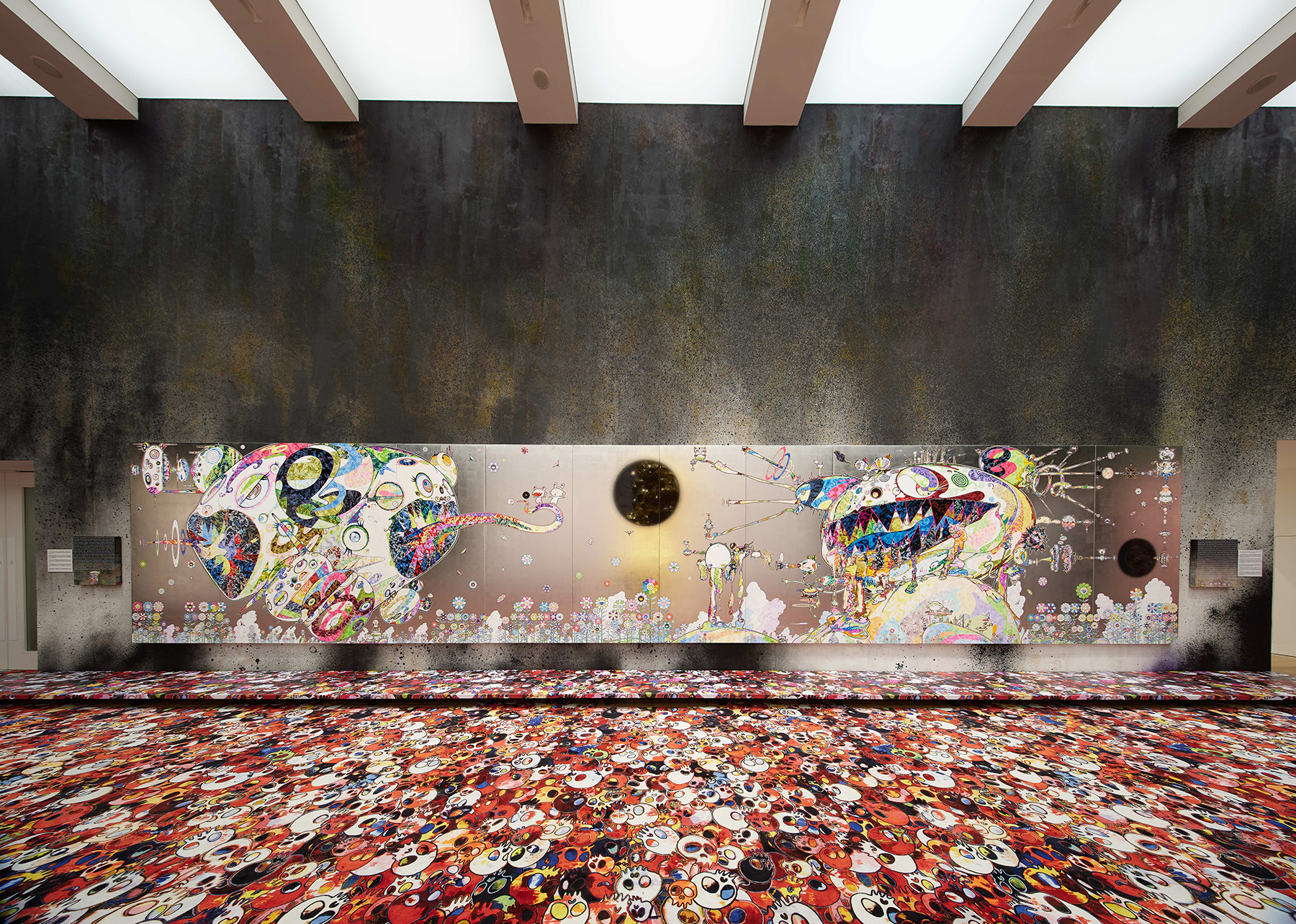Shows
Roundtable Review: “Murakami vs Murakami”


Co-curated by Tobias Berger, heard of art and curator at Hong Kong’s Tai Kwun Contemporary, and Gunnar B. Kvaran, ex-director of Oslo’s Astrup Fearnley Museet, superstar artist Takashi Murakami’s survey exhibition “MURAKAMI vs MURAKAMI” was displayed across all three floors of Tai Kwun. With the goal to showcase “the divergent extremes of the artist’s oeuvre,” the exhibition began on the top level with a monumental sculpture, canvases, and custom carpet related to the theme of “chaos.” From there, visitors delved deeper into the artist’s “sci-fi otaku brain” by way of his art collection, which spans works by spraypainter MADSAKI, portraitist Tomoo Gokita, Pop Art legend Andy Warhol, and illustrator Horst Janssen. On the second floor was a selection of Murakami’s elaborate costumes, housed in glass vitrines. One level down, galleries contained Murakami’s more “optimistic flower works,” animations, artwork sketches, paintings inspired by Francis Bacon, and, lastly, all-gold Enso paintings, in front of which viewers were meant to “reflect on nothingness and finitude.” Here is what members of the ArtAsiaPacific team thought of the exhibition.

“Frivolous escapism”
Tai Kwun’s survey of Takashi Murakami’s practice was maximalist in scale and scope, with animated videos, monumental sculptures, and explosively colorful paintings and textiles teeming with images of smiling sunflowers, and various characters invented by Murakami or appropriated from anime and manga. This frenetic visual spectacle will satisfy visitors eager for a photo-worthy backdrop.
Yet those expecting to look beyond Murakami’s Superflat aesthetics and excavate any deeper meaning in his works will probably be disappointed. As much as Murakami claims his works have serious underlying themes, such as nuclear disaster and death, it is naive to believe—as the exhibition catalogue claims—that a room-sized carpet inundated with vivid cartoon skulls serves as a “visceral memento mori,” or that a giant gold sculpture of a mutant is capable of evoking the devastation of the 2011 Fukushima nuclear tragedy. Furthermore, the curators’ attempts, via ancillary texts, at drawing art historical associations between, for example, Murakami’s densely patterned surfaces and Abstract Expressionist canvases, or between his gold-leaf covered Enso Room and Andy Warhol’s silver-painted Factory felt tenuous, leaving one to wonder whether these were a desperate effort at affirming Murakami’s work. Nevertheless, considering the many serious political, environmental, and socioeconomic problems that we currently face, surely a little frivolous escapism into Murakami’s fantasy world does no harm. EVELYN GOH

“Murakami in all his humanness”
The main draw of “MURAKAMI vs MURAKAMI” was the selection of works from Takashi Murakami’s private art collection, which encompasses photographs by Wolfgang Tillmans and Hiromix, paintings by Julian Schnabel, MADSAKI, and Kodai Nakahara, as well as a sculpture by Yoshitomo Nara. Highlights included the five affective, black-and-white photographs Nobuyoshi Araki took of his wife, whom he documented over two decades until her death in 1990.
This collection––along with everything else in Murakami’s solo show––was justified by a panel from a series aptly titled Excuse Paintings: barely legible vinyl or printed texts on canvases, bubbling over with contradictory admissions, heavy-handed debasement, self-praise, and complaints. Like in the rest of the series, the tone of voice wavers in the text. Explaining his penchant for collecting, Murakami tells us that after nine “dull” years spent earning his PhD, he “luckily” became a professional painter, and now, he is a “mere good-for-nothing collection addict wasting company money.” First self-aggrandizing then self-deprecating, he pleads with you to either pity or revere him, or both.
Make no mistake, Murakami is articulate in the lingo of popular culture, au fait with kitsch and kawaii, and well versed in Superflat perfection. He is indisputably recognized worldwide as a “superstar artist.” Yet, the show’s inclusion of these Excuse Paintings uncovered Murakami in all his humanness. Mounted alongside his flawless paintings, outlandish costumes, and extensive private collection, his confessions revealed there really is a battle going on: Murakami vs Murakami. LEORA JOY JONES

“Defensive overintellectualizing”
To the left of the entrance at the third-floor gallery—re-done by Takashi Murakami to boast spraypainted walls and a dizzying carpet depicting multicolored skulls—was a panel emblazoned with the word “CHAOS.” Below this header were Murakami’s printed reflections on Tobias Berger’s request for the artist to create “a chaotic background” for this space. The twisted logic of crafted chaos sums up the main problem with “MURAKAMI vs MURAKAMI:” contrivance.
The artist’s tiresome, meandering panels of text hammered home his supposed engagement with the value of art, but offered little beyond self-deprecating professions of bemusement as to the workings of the market. The texts also made a point of reiterating the Dark Adult Themes that lurk beneath the shiny surfaces of Murakami’s compositions, though it remains unclear how exactly the sparkly voids and rainbow mutants of Bacon: Scream and Tan Tan Bo Black Hole (both 2019), for instance, are meant to inspire existential dread. All this is not to say there is no joy to be found in viewing Murakami’s monumental sculptures, canvases, and costumes of his well-known anime-inspired characters and grinning flowers. What saves the show is the intrinsic and undeniable lightness of Murakami’s chosen aesthetic, which underscores the offbeat sensibilities of a figure who perhaps has such widespread appeal precisely because he doesn’t take art too seriously. A show that embraced that instead of resorting to defensive overintellectualizing would not have been remiss. OPHELIA LAI

“Self-reflexive examination”
As the title suggests, “MURAKAMI vs MURAKAMI” was Takashi Murakami’s self-reflexive examination of his seemingly oxymoronic artistic impulses. Since the early days of his career, the artist has struggled with finding his place between “high” and “low” art, often settling for blending the customs of both in his practice. Throughout the exhibition, his distaste for the hierarchy separating the two categories was reflected in the persistent use of his anime-inspired, kawaii style—or “Superflat” aesthetic, a term he famously coined—for topics ranging from the Fukushima nuclear disaster to Francis Bacon’s oeuvre, and the philosophies of Zen Buddhism. Despite Murakami’s divergent subjects, it was his personal quandary regarding the Japanese art scene that was most prominent, with each artwork’s descriptive placard alluding to the topic in some way. For example, the Enso room is accompanied by Murakami’s praises for Japanese traditional arts, while the sculpture The Birth Cry of a Universe (2005–19) is a self-proclaimed rally against such traditions. In short: Murakami is enamored with manga illustration, yet enmeshed in the Japanese art industry, which derides it.
To further demonstrate his disparate artistic interests, Murakami displayed a selection of zany, colorful cosplay costumes alongside monochromatic, decidedly “high art” Nobuyoshi Araki prints, both from his collection—a statement of his simultaneous positions as otaku and art connoisseur. The exhibition provided no concrete links between the divergent headspaces that Murakami occupies. Instead, it was made clear that the only connective theme is Murakami himself, and his acknowledgement of the human tendency towards internal contradictions. KATE LAU

“Disconnected from real fears and struggles”
Paradoxes pervade the practice of Takashi Murakami. His candy-colored creations appear to be purely aesthetically driven, and are at home in the realm of pop culture, where they can be consumed quickly by mass audiences. Yet, the same images also critically comment on contemporary cultures, and delve into historical narratives of human suffering.
This intriguing duality of deep and shallow, dark and light, was evident throughout Murakami’s survey exhibition, and felt most condensed in the top-floor gallery. Departing from the show’s other vivacious displays, the room presented Murakami’s multimedia series inspired by the 2011 Tohoku earthquake and tsunami, and Fukushima nuclear disaster. At the gallery’s center was the monumental sculpture, The Birth Cry of a Universe (2014), gleaming with its perfectly smooth, golden surface. A deconstruction of Murakami’s cartoon avatar, Mr. DOB, the distorted body with multiple heads and rows of sharp teeth protruding from its side sits on a lotus throne, typical of Buddhist icons. Surrounding the work were six paintings with a skull pattern, which extended onto the carpet that covered the entire gallery floor. Viewers were immersed in these images symbolizing death, despair, and alienation, and yet, the works hardly achieved empathy among viewers. Here, the Superflat surfaces that recur throughout Murakami’s practice are also shields resisting contextualization. Serving as the backdrop of hundreds of selfies, this chapter of Murakami’s exhibition, though supposedly endowed with deeper, richer meanings through its references to the catastrophic events, felt disconnected from the real fears and struggles that it drew from. CASSIE LIU

“Solipsistic/schizophrenic”
Your heart breaks a little reading about the woes of Takashi Murakami in his solipsistic/schizophrenic exhibition “MURAKAMI vs MURAKAMI.” Throughout, the megastar artist inserted his Excuse Paintings, small canvases of tedious, self-pitying commentary explaining, for instance, how because he has so many exhibitions now that he’s a megastar artist he didn’t actually have any time to think of a new painting for the show until the last minute, so he used a drawing by Shisho, his assistant of 20 years; or, despite claiming to have more than 100 employees in his studio, he had to personally make repeated trips from Tokyo to Kyoto to buy more dye for the 7-by-70 meter backdrop on the third floor. The third floor’s theme of “chaos”—with dark-stained canvas walls, monumentally creepy paintings of Mr. DOB, Tan Tan Bo, and others (all shades of self-portraiture), a nightmarishly ugly carpet of skulls, and a 4.5-meter-tall cancerous golden monster The Birth Cry of a Universe (2014)—encompassed his managerial incompetence and TMI disclosures about his neuroses. Speaking of “birth cries,” if you are psychoanalytically inclined, there is plenty of gratuitous material to work with, including: a complete timeline of Murakami’s life with trivia about his need to please his nationalistic father and high-achievement-promoting mother; a showcase of cosplay costumes that serve as his “armor” in anxiety-inducing social contexts; a superfluous display of compositional drafts evidencing the sadistically menial “labor” he forces upon his studio employees; his re-interpretations of Francis Bacon’s erotically charged portraits; and, finally, an all-gold room, where, amid the hermetic, circular dripping strokes of his Enso paintings, he’s placed high on the wall a single yellow canvas depicting ejaculate. It’s a boy’s world of bodily fluids (and solids), fixations and daddy complexes, where the anxiety of influence still runs wild. The question is, who cares? HG MASTERS

“Expands the dimensions of anime aesthetics”
Visitors to “MURAKAMI vs MURAKAMI” were bombarded by Takashi Murakami’s iconic compositions filled with smiling flowers, and his characters Kaikai and Kiki, as well as the robotic cat Doraemon, whom multigenerational Hong Kong audiences will know from the popular Cantonese-dubbed Japanese television show first broadcast in 1982. Ubiquitous were the manga scenes of Doraemon and Nobita navigating their time machine or flying using helicopter blades attached to hats, cloned repetitively onto various canvases. In this adoption of such iconic Hong Kong characters and scenes, I could see that Murakami was perhaps attempting to bond with the local crowd—but one eventually becomes overwhelmed and numbed by the relentless duplication of images.
In contrast with the bland reproductions of Doraemon were other works that successfully marry anime and contemporary art, such as The Birth Cry of a Universe (2014). This sculpture, comprising gold leaf on fiber-reinforced plastic, portrays a threatening, sharp-toothed, phlegm-spitting mutant sitting atop a lotus flower—a motif traditionally seen in Buddhist murals and statutes. Here, die-hard anime fans might be able to recognize elements of the character Tan Tan Bo, a monster from the 1960s manga series Kitaro of the Graveyard, and Murakami’s own big-eared cartoon figure and alter-ego Mr. DOB. The mutant’s grotesque, deformed appearance hints at the effects of radiation—a topic the artist has continually addressed in his works since the Fukushima Daiichi nuclear disaster in 2011. In appropriating anime characters and conveying social issues, the sculpture enriches the meaning of and expands the dimensions of anime aesthetics. PAMELA WONG
HG Masters is ArtAsiaPacific’s deputy editor and deputy publisher; Ophelia Lai is reviews editor; Pamela Wong is assistant editor; Evelyn Goh, Leora Joy Jones, Kate Lau, and Cassie Liu are editorial interns.
Takashi Murakami’s “MURAKAMI vs MURAKAMI” is on view at Tai Kwun Contemporary, Hong Kong, until September 1, 2019







